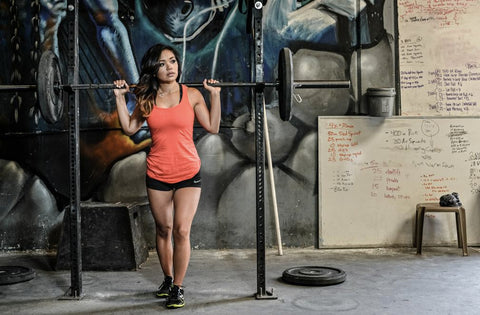What is Progressive Overload?
You’ve all seen them before: that one gym regular – Average Joe, we’ll call him – with a big ego who stomps his way under an Olympic barbell loaded with plates on plates on plates. He’ll huff, he’ll puff, and then he’ll squeak out a little curtsy before making his way make up and dramatically racking the bar on the pins. “Yeah, 400lbs,” he’ll grunt as he beats his chest. “Man, can you believe that last year I was only squatting 135?”
You know just as well as any other onlooker, however, that he traveled all of six inches. And that over time, his range of motion has gotten increasingly shorter, rest between sets longer, and ego exponentially larger. So does that even count? Do you give it to Average Joe?
Let’s wipe the slate clean and start over. Average Joe could learn a lesson or two here.

Traditionally, we think of progressive overload as simply adding more weight onto the bar. That’s very straightforward and, if that’s the only way you make improvements in the gym, you’ll probably end up doing pretty well with your fitness endeavors.
But there are many ways to get better in the gym beyond striving to increase absolute poundages.
Progressive overload, simply defined, refers to the ability to do more over time. And while this may seem straightforward, gauging true progressive overload is a lot like the scientific method: keeping all other training variables constant, you change only one thing. If you are able to make an improvement in the gym while controlling all other variables, then you can say that you have truly progressed. After all, if you change two or more factors in a given environment, how can you tell if you’ve really made progress? There would be one too many confounding factors to be able to come to a decisive conclusion.
Below I’ll go over the different angles with which progressive overload can be approached.
Load
If you’re a complete beginner to strength training and have been sedentary for a long time, I’d recommend starting out with just bodyweight or a very light load for the basic movement patterns. If you’re simply trying out a movement for the first time but you’re otherwise experienced in the weight room, it’s still a good idea to experiment with a couple of light sets.
Whatever your starting point, there’s going to come a time – sooner rather than later – when you’re going to want to slide some more plates onto the bar, grab a heavier kettlebell, or bump up the dumbbells by 5lbs. In order for the body to adapt, you must continue to push the boundaries and place the muscles under additional stress. This is known as increasing mechanical tension, and it’s critical for long-term gains in strength and muscularity.
Here’s a video of me hip thrusting 265lbs for 2 reps at 108lbs bodyweight back in May 2015. The first time I ever did hip thrusts was in March of 2012 and I could only do 65lbs at the time.
How do you know when you’re ready for more? When you can complete the set within the prescribed rep range with ease. In other words, if you feel like you could have rocked out five more reps with solid form, that’s a good sign you can handle a little extra weight.
Alternatively, you’re also progressing if you’re lifting the same amount of absolute weight but with less bodyweight. Your relative strength, in this case, is said to have improved. If you lose weight while maintaining strength, then this, too, is considered a form of progressive overload.
Regardless of what your fitness goal is – be it fat loss, strength, maintenance, or muscular endurance – you should be always striving to get stronger in this aspect. Remember, though, that the quality of the movement (meaning your form) should never be compromised for the sake of quantity. Get your form right before allowing yourself to move up in weight.
Volume
Manipulating volume in the gym can mean many things. The most simple interpretation is to change the numbers of sets and reps of an exercise performed. If a weight is feeling light, for example, you may want to get in one or two extra reps depending on the rep range you’ve been prescribed. In this regard, you can progress by increasing the volume of a set or training session by getting in more reps while keeping the weight, rest, and tempo fixed.
Another way to switch up the volume is by the frequency with which you train. If you’re a beginner who’s been lifting two days a week for a couple of months, perhaps you’re ready to bump that up to three or four days a week now. If your focus is on hypertrophy of a specific body part, it’ll definitely be a good idea to start training said area more than just once a week.
Related to volume is a concept called time under tension (TUT), which is great because it creates mechanical stress, one of the mechanisms for hypertrophy as defined by Brad Schoenfeld. TUT typically refers to the duration of a given set. In order to increase TUT, then, you can simply execute more repetitions in a set or even perform more sets overall.
And let’s say you do 4 sets of 5 squats at 185lbs with 2 minutes rest between sets. If you manage to add 10lbs to that squat the next week but you’re resting 4 minutes between sets, can you really say that you’ve progressed? That’s hard to say because you’ve changed two different variables: load and rest. How do you know that you couldn’t have done 195lbs the week prior if you’d given yourself more rest then also? The confounding variable will make it difficult to come to any real conclusion.
To manipulate rest in order to progress, rest a little less than you usually do and attempt to perform the same set again – with the same weight and the same numbers of reps. This is know as increasing the density of the training session. If you do this successfully, then congratulations! Progressive overload has taken place.
Range of motion
If you’re doing a set of squats and you start to get tired, what are you tempted to do? Shorten the range of motion. You’ll eek out a half squat – or worse, a quarter squat – and try to pretend that that was a legitimate rep. In order words, you’ll cheat yourself of quality for the sake of quantity. Many lifters see this as a form of progressive overload in that they’re extending the set with partials. However, this grey area makes it very difficult to gauge progress.
To make a set more difficult by extending the set beyond failure, you may alternatively strip off half the weight and continue to execute full range of motion. This is referred to as a mechanical dropset, which allows you to continue banging out full range repetitions while increasing TUT and metabolic stress. This approach is that much more appealing as progress can be easily measured. As each repetition is performed for a full range of motion, when you can increase the total reps in the set, you can be sure that progressive overload has been achieved.
Coming from another angle, progressive overload for someone may mean progressing from rack pulls to conventional deadlifts after developing the mobility to reach down that low. Or perhaps it’s simply a matter of building the body awareness to now be able to safely achieve proper depth without injury. Anecdotally, the lifters who pay more attention to form and honor full range of motion seem to last longer in terms of training careers than the lifters who don’t, as they tend to keep more stress on the muscles and less on the joints and ligaments.
Granted, there’s necessarily going to be some degree of individual variation. Depending on injury history, body structure, and mobility, “full” range of motion for someone might mean only going down to a parallel squat, whereas for someone else with incredible ankle and hip mobility, an ass-to-grass approach might be more appropriate. However, rest assured knowing that if you can now full squat the same weight as you could parallel squat 6 months prior, then you’re using greater ROM, and thus, progressive overload has been achieved.

It’s fun to make progress in the gym – that much is undeniable. But there are still important notes to keep in mind.
As emphasized earlier, proper form trumps everything. There’s no sense trying to advance an exercise if you’re looking sloppy. Spend some time hammering out quality form before moving forward. I understand this may come off as a painfully obvious point, but I’d argue that the vast majority of cases of poor form you witness in commercial gyms around the country begin by violating this basic rule. Simply put, lifters compromise their form and ROM in order to fool themselves into thinking they’ve gotten stronger – and oftentimes end up hurting themselves in the process. Safety first.
Progress is by no means linear, so to expect to make the same degree of gains week after week is unrealistic. The more experienced you are, the harder it’s going to be – meaning you’ll have to input more and more work to achieve increasingly smaller gains. On top of that, there are other factors such as diet, sleep, stress, underlying injuries, and genetics that will affect the rate at which you improve.
For beginners especially, progressive overload is an entirely different animal. Oftentimes this means that the individual should first master the basic movement patterns with strictly bodyweight before even thinking about adding weight. This person may likely have to begin with the most rudimentary version of a movement, and then slowly move onto the more advanced variations as he or she gains body awareness. Once this body awareness has been achieved, however, the beginner is ripe for growing, as the term “newbie gains” has been coined to refer to the typical results a lifter sees in his or her first three to six months of engaging in proper resistance training. It’s a time for rapid progress, so make sure a proper foundation of sound technical form is laid before piling on the plates. This will pay dividends in the long run.
Forge ahead, my friends.
References
Schoenfeld, Brad. (2013). Potential mechanisms for a role of metabolic stress in hypertrophic adaptations to resistance training. Journal of Sports Medicine, 43(3):179-94.




